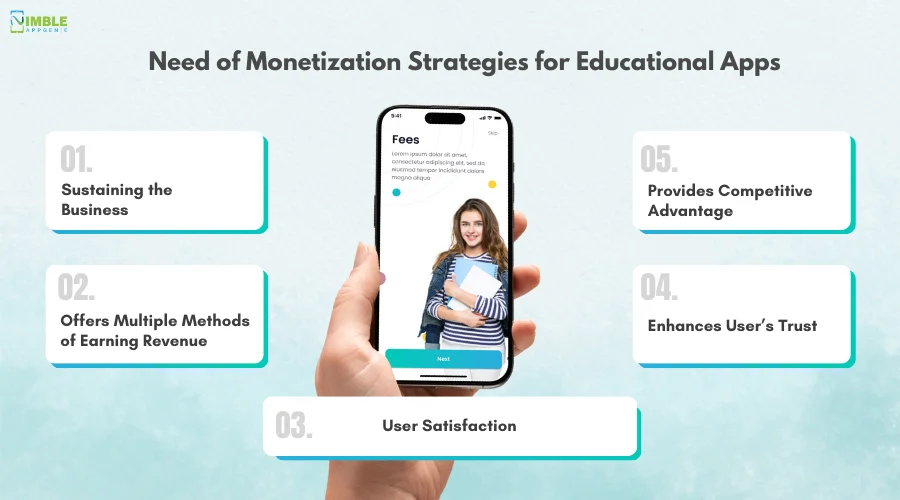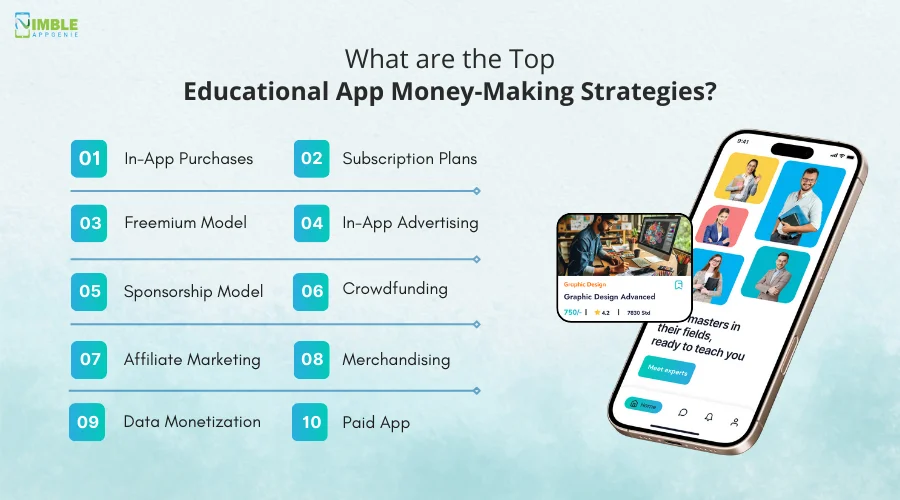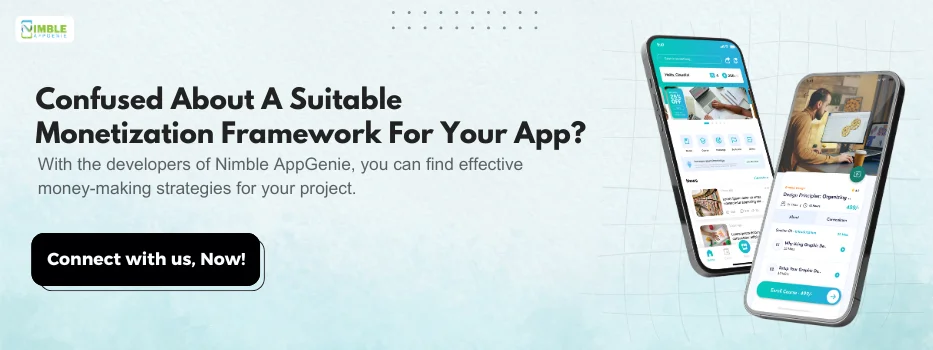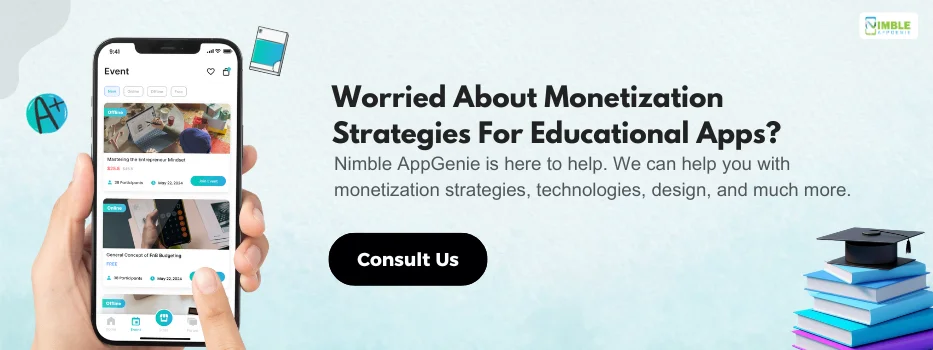When you are in the educational business, the money-making strategy is simple, you just need to take fees for the students, right?
But, what about educational apps? How do Educational apps make money?
Well, there are many monetization strategies that you can implement in your project to make money such as in-app advertisements, in-app purchases, data monetization, and many others.
However, not all monetization strategies are suitable for every educational app. Here you need to identify the aim and end goal of your business.
Let’s dive into the details of educational app money-making strategies.
Overview of Educational App Monetization Strategies
What is a money-making strategy for educational apps, and why is it important to work?
Well, let’s begin with the concept.
A monetization strategy is a plan that aims to generate revenue through the platform, content, audience, and different sources.
When it comes to educational apps, it’s hard to implement the strategies. However, with the right frameworks, you can overcome such issues.
Educational app monetization strategies are a way to engage the target audience and earn high revenue and commissions. This revenue will be effective for running the business in this competitive market.
Need of Monetization Strategies for Educational Apps
Before you implement effective monetization strategies for educational apps, it’s important to learn why it’s necessary.

Here’s a detail to continue with.
♦ Sustaining the Business
With an effective and successful monetization strategy, you can sustain the business in the long run. It is a very important method to continue business. With earning profits, you can successfully enhance the business network and engage a wide audience.
♦ Offers Multiple Methods of Earning Revenue
By selecting money-making strategies for educational apps, you can go ahead with the multiple methods of earning revenue. Here it will be useful in engaging the target audience by implementing useful methods such as in-app purchases, in-app advertising, etc.
♦ User Satisfaction
If you are able to understand the wise implementation of monetization networks with the user preferences that align with their needs, then your app will thrive as you enhance the users’ loyalty.
♦ Enhances User’s Trust
An educational app that has effective monetization strategies is trusted more than a software that offers free services. Hence adopting the right educational money-making strategies will help you to enhance users’ trust in the brand and enhance their interest in learning.
♦ Provides Competitive Advantage
Implementing the right framework can be useful in adding competitive benefits to your brand. This will increase your brand’s recognition among prospective buyers. This will provide you an overhand on the competitors and take away the market.
Well, considering these reasons can be helpful for you to continue with implementing the right and imperative monetization strategies.
What are the Top Educational App Money-Making Strategies?
It’s important to select the right monetization strategies to lead the industry.

So, here is a list of mobile app monetization strategies to consider for educational apps.
1. In-App Purchases
This is a model that allows the users to utilize most of the educational app services for free. Via in-app purchases, your app can include certain essential features to attract users and this will be useful in customizing the app.
It is the perfect way for users to customize their experience by purchasing the type of features that they prefer within their educational apps. This is extra content or subscriptions that are buried inside an app.
This is a crucial strategy, where you can integrate features that might look essential for the users to engage them in the long run.
In-app purchases are a way where you can increase the revenue potential of your business by providing more value and customizations to the users. With this strategy, you can incentivize them to spend more time and money on the app.
For instance– In educational apps, after using the free version, the app provides an offer to the users to have access to additional content or previous years’ papers with some purchases.
2. Subscription Plans
Subscription plans within educational app monetization is an important segment where the users can buy the plans according to their feasibility.
Within the subscription plans, you need to put different prices based on the type of features and technicalities provided. It is a plan where the content can be updated regularly, by providing the users with fresh material by adding new courses, inviting guest experts, as well as offering live workshops for recurring payment.
Under subscription plans, the app offers monthly, quarterly, or annual subscription plans which may provide you with a steady revenue stream. This is a type of model where you can help users with multiple plans and or can make customized plans based on their preference.
These are the users who see ongoing value in your app and are more likely to commit to a subscription such as receiving updates, personalized learning experiences, along with exclusive content.
For instance– With educational apps, you can offer various subscription plans that can be monthly, weekly, or annually.
3. Freemium Model
Freemium models are among the most popular monetization strategies for educational apps. This is one of the most effective ways to engage the users by offering the core features for free. Under this model, the users can get access to all the features when they pay an added amount.
Here, users can start for free and may pay to unlock further content or deeper features. If you want to develop an app like Duolingo, you can use this model to earn money successfully.
This model is effective for the model “try before you buy”. Here users test the app and all its functionalities before they pay to unlock all the features and other functions. With the premium version of the app, the users can access advanced features as well, such as 24/7 hour support services and much more.
This version can get you access to a permanent source of revenue. It is a way where you can attract a large user base and showcase the value of your app. With this strategy, you can encourage the users to upgrade it for more benefits.
For instance- Duolingo uses the freemium model, where it offers a large part of its educational content at no cost to the users.
4. In-App Advertising
It is a common money-making strategy for educational apps. Here you can connect with other brands and companies to promote their products and services on your platform.
Here you showcase ads from third-party networks or sponsors and help other brands and sponsors to reach their target audience. An important prospect to consider here is that you should post ads that can provide you benefits both in terms of money and business.
Additionally, you should be careful not to show too many irrelevant ads because this can annoy and distract the users and can further impact their learning experiences.
In this manner, you can keep your app free or low-cost for the users and can leverage the data insights from your app to optimize the ad performance. For the educational apps, you can display the ads of notebooks, or stationary items in collaboration with such brands.
For instance- Udemy earns money by advertising other brands over its platform along with other monetization strategies.
5. Sponsorship Model
Within the sponsorship model, you can partner with a brand or an organization that aligns with your app’s mission and audience, and offer them exposure or access to your users in exchange for funding or resources.
In such a manner, you can reduce the development and marketing costs by enhancing the credibility and reputation of the business. Under this model, you have to select your sponsors carefully and need to maintain your editorial independence.
These are a form of advertising that assist the companies to reach a wider audience and enhance brand recognition. Edtech companies can collaborate with educational institutions to co-create and sponsor content. Additionally, such collaborations can offer an extra source of income.
Sponsorship models can provide a better return on interest than other traditional sponsorship methods. It is based on the concept of receiving financial support from another business or individual who can be termed as a sponsor.
For instance- Duolingo uses a sponsorship model to build a great network and connect with multiple brands.
6. Crowdfunding
Crowdfunding can help your educational app inject funds within a venture, especially in the early stages of a business. It is a practice of raising small amounts of money from a large number of people.
This can be useful for your educational businesses to raise capital and fund all the new projects. Additionally, entrepreneurs can make use of crowdfunding to finance their creative ideas as well as to cover any kind of damage.
With the help of this strategy, businesses can offer convenience, reduce risks, and provide real-time feedback. For educational businesses, you can finance a new venture.
This strategy can be useful in connecting with a diversified audience and later you can provide these users interest and dividends based on their funding for the educational business.
For instance- This is the best strategy when you are starting up your educational app business.
7. Affiliate Marketing
It is a type of marketing, yet it is a useful and effective medium for higher education and to reach a wider audience. With this strategy, you can leverage the expansive reach of the established affiliates within diverse online channels.
This strategy can be useful in attracting qualified students and ultimately achieving enrollment goals. With this kind of model, you can promote third-party services or products to optimize the app revenue opportunities.
Additionally, app publishers can promote or sell the affiliates’ products or services based on the clicks and number of installs.
Thus, with this strategy, you can earn a commission by promoting the other brands’ goods and services. This is an effective way to earn regular monetary revenue.
For instance- you can implement various affiliate programs such as Babbel, Teachable, school, and many others.
8. Merchandising
You can merchandise the educational courses by selling t-shirts associated with top educators or an educational kit to engage the users and earn regular revenue.
This strategy can be helpful by making the products more price-competitive, and by encouraging more customers to visit the store. It can be effective for your business to enhance overall revenue.
It will assist you in enhancing customer satisfaction and loyalty. This will help you get more profits, by increasing sales and is a possible way to attract more customers. Additionally, you can liquidate the products more easily.
With this strategy, you can promote products and enhance sales on a digital landscape. Here you need to adjust the prices to manage the profit margins across products by selling them over digital platforms.
For instance- Khan Academy merchandise earns great revenue and income. It is an important way to make money.
9. Data Monetization
Under the data monetization you collect, analyze, and evaluate the users’ data with their consent. This represents an opportunity where you can use something that you have already created by building an educational app.
If you have a large user base, this can act as an opportunity for you to monetize this data in exchange for revenue. Additionally, new revenue can come from selling or licensing the data externally.
However, another concern to undertake here is obtaining consent from the users. If you are using their data without their permission, then it can lead to impact your complete money-making procedure.
With this act, you can strike a balance between making a profit and providing real value for money to the end users.
For Instance- This type of strategy should be used only after obtaining permissions from the users.
10. Paid App
It is the strategy, where users once paid for an app when they go ahead to download it, then it was theirs to keep. This monetization strategy is effective when your app offers substantial value to the target users.
The value should be substantial and needs to be offered right out of the gate, including comprehensive educational courses and exclusive learning materials that these users can’t find anywhere else.
If you are implementing this strategy, you should ensure that your app provides a certain value to the end users. This value should add a change in their lives if they are paying for the same.
Additionally, you should ensure that you can get a return on investment while implementing this monetization strategy for educational apps.
For Instance– Here you should make clear over the Play Store that the users need to pay the defined amount before downloading the app.
Well, even after studying these different patterns of money-making for educational apps, you need to examine what’s best for your customized project. Hence connecting to an experienced company can help.
How Nimble AppGenie Assist in Adopting App Monetization Strategies?
Are you the one bothered to implement monetization strategies in your app?
Connect with Nimble AppGenie and identify the suitable type of monetization strategy to enhance the value of your app in the competitive market.
We are a leading educational app development company focused on providing value to your dream. Our team can perform effective market research and may help you with all types of assistance development, money-making strategies, and maintenance.
You can check out our latest work below.
GLU –E-learning app is an educational app created by our team that has engaged and attracted diverse users.
Conclusion
Before you implement a suitable monetization model, it’s essential to identify the monetization strategies that are effective for your business.
Connecting with an experienced company can help identify an effective monetization strategy for your brand.
FAQs

Niketan Sharma is the CTO of Nimble AppGenie, a prominent website and mobile app development company in the USA that is delivering excellence with a commitment to boosting business growth & maximizing customer satisfaction. He is a highly motivated individual who helps SMEs and startups grow in this dynamic market with the latest technology and innovation.
Table of Contents






No Comments
Comments are closed.